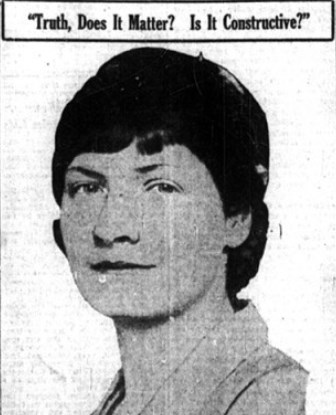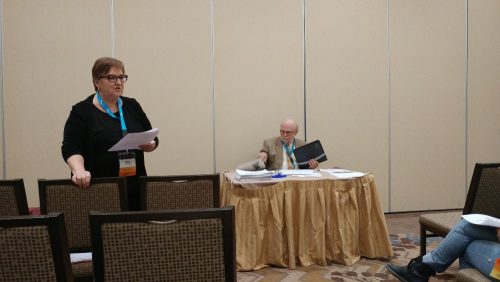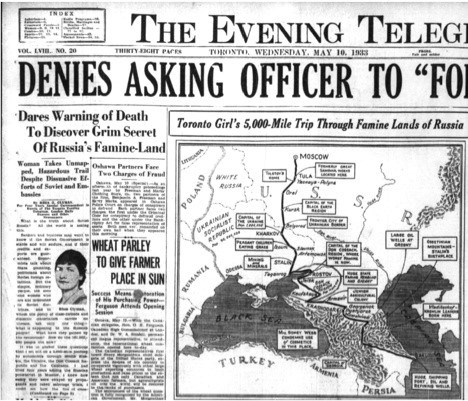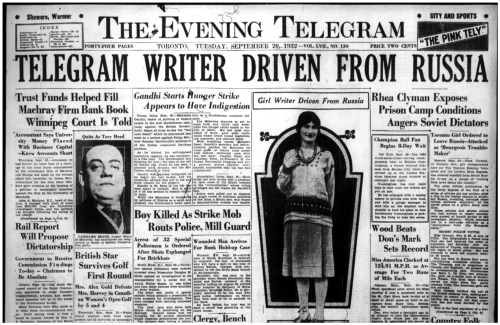New Chapters in the Ukrainian-Jewish Relationship Explored at Canada’s Limmud FSU (Part 1) – Rhea Clyman

The story of a Poland-born Jewish journalist navigating Soviet Ukraine to bring to the international community the story of a man-famine of 1932-1933 on that territory. A discussion of stereotypes and misperceptions between Ukrainians and Jews from times past to the present.
Speaking to enthusiastic audiences, Jars Balan of the University of Alberta and Paul Robert Magocsi of the University of Toronto revealed unknown chapters and questioned age-old stereotypes at two panels sponsored by the Ukrainian Jewish Encounter at Limmud FSU Canada, which took place at Blue Mountain Resort in Ontario on 24-26 March 2017.
Founded in 2006, Limmud FSU (former Soviet Union) aims to revive the tradition of Jewish education and strengthening the Jewish identity of Jews whose roots are in countries that traditionally have had large Russian-speaking populations. The UJE in the last three years has participated in and sponsored conferences organized by Limmud FSU in Ukraine, Canada, the United States, and Israel.

Balan discussed in his hour-long presentation the remarkable life and work of Rhea Clyman, a journalist little known today in the Jewish or Ukrainian communities, but who in her day reached international acclaim for her coverage of the Soviet Union, including the 1932-33 man-made Ukrainian famine known as the Holodomor, and the rise of Nazi Germany.
Balan is coordinator of the Kule Ukrainian Canadian Studies Center for the Canadian Institute of Ukrainian Studies at the University of Alberta. During his research on the Holodomor, he stumbled onto Rhea’s reports and is currently working on a film about her time reporting in the Soviet Union.
Born in Poland, Clyman immigrated to Canada with her family in 1906 as a two-year-old. She grew up in Toronto, and lost a leg in 1910 when she fell under a streetcar. From early on, she knew her life’s ambition; when an editor from the now defunct Toronto Telegram asked her during a hospital visit what she wanted to be when she grew up, her swift response was “a journalist.”
“He gave her a Bible and told her everything you need to know about writing is here,” said Balan.
Clyman went to secretarial school, and in 1925 took a job in New York with a psychoanalyst for several years. She then landed a job in London, England as publicists for the agent general of Alberta’s provincial government, which put her closer geographically to achieving her goal of going as a journalist to the Soviet Union. At that time, the country, with its stated workers’ rights, gender equality, and social welfare inspired many young people as an ideal society.
After a stint in France and Germany, Clyman secured a visa to enter the USSR. On 23 December 1928, she boarded a train in Berlin headed for Moscow, not knowing anyone there, nor a word of Russian.
Balan said it is possible Clyman received the Soviet visa because she may have joined the Communist Party and become a courier for it; he recently came across a British MI5 report where Clyman was mentioned as a possible party courier.
With 15 British pounds sterling in her pocket, Clyman spent her first night in Moscow sleeping in the bathtub of a well-known American reporter. But she soon landed a job with Walter Duranty of the New York Times. She eventually picked up enough Russian to begin working as a special correspondent for various publications, including the influential London Daily Express, and became journalistically well connected.
“Initially I think she was caught up with the enthusiasm for the Soviet Union for what she saw, but I think gradually she came to understand this was a horror story that was unfolding before her eyes,” said Balan.
One of episodes that likely prompted a change in her views was when her Russian boyfriend was arrested and sent to Siberia for dealing in currency exchange, Balan said.
In the summer of 1932, Clyman traveled north to see the labor camps in Karelia. On her way there she passed through colonies that were built by idealistic Westerners who moved to the Soviet Union, and visited the closed city of Kem, on the White Sea, the administrative and supply center for the infamous Solovetsky Island prison.
At first she was thrilled that she managed such a journalistic feat, Clyman wrote in a story that appeared in the Toronto Evening Telegram on 3 October 1932.
“I realized that I had accomplished the impossible. Gate-crashed Kem – the last train gone an hour ago – and found a clean room for the night. I felt exultant and broke into laughter.”
Her joy quickly ebbed, when she saw the face of the housekeeper who was “spreading fresh clean linen” on her bed.
“One look at the horrified face of the woman and every trace of fun in me died out.
‘What have I done?’” I asked hurriedly.
“You were laughing,” she replied. “I’ve been in this town three years and I’ve never heard anyone laugh before. We Russians have forgotten how. This is the town of the jivoi troop (living corpses). Write this. You are a journalist. Tell the world outside so others may know. I was awed into silence. Quickly the gloom and fear that hung over Kem settled on me. Even the gay sunshine streaming into my room could not lift it.”
“So I’m here to fulfill her job, to tell about it,” Balan said.
Clyman wrote a series of stories about Kem, then mining camps, where the living conditions were horrific.
 After her return to Moscow, Clyman embarked on another journey, this time with two socialites from Atlanta, who needed her as a translator for the trip.
After her return to Moscow, Clyman embarked on another journey, this time with two socialites from Atlanta, who needed her as a translator for the trip.
The trio traveled several thousand miles from Moscow through Yasnaya Polyana and Kursk to the Eastern Ukrainian cities of Kharkiv, Sloviansk, Izium, and Donetsk. The trip also took them through the Kuban region in the north Caucasus and on to Tbilisi, Georgia. They traveled through rural and industrial areas where the impact of the Five-Year Plan and forced collectivization was abundantly evident.
Unlike Duranty, who in his reporting for the New York Times denied a human-instigated famine was occurring in Soviet Ukraine, Clyman’s reports ran under headlines that read: Children Lived on Grass Only, Food in Farm Area Grain Taken From Them, Mile After Mile of Deserted Villages in Ukrain[e] Farm Area Tells Story of Soviet Invasion.
“When we arrived at the next village men, women, children and shaggy coats all came crowding out of the narrow doorways,” Balan said, quoting from a story that appeared in the Toronto Evening Telegram on 16 May 1933.
“They wanted something of me, but I could not make out what it was. At last someone went off for a little crippled lad of fourteen, and when he came hobbling up, the mystery was explained. This was the Village of Isoomka, the lad told me. I was from Moscow, yes; we were a delegation studying conditions in the Ukraine, yes. Well, they wanted me to take a petition back to the Kremlin, from this village and the one I had just been in. “Tell the Kremlin we are starving; we have no bread!” We are good, hard-working peasants, loyal Soviet citizens, but the village Soviet has taken our land from us. We are in the collective farm, but we do not get any grain. Everything, land, cows and horses, have been taken from us, and we have nothing to eat. Our children were eating grass in the spring…
“I must have looked unbelieving at this, for a tall, gaunt woman started to take the children’s clothes off. She undressed them one by one, prodded their sagging bellies, pointed to their spindly legs, ran her hand up and down their tortured, mis-shapen, twisted little bodies to make me understand that this was real famine. I shut my eyes; I could not bear to look at all this horror. “Yes,” the woman insisted, and the boy repeated, “they were down on all fours like animals, eating grass. There was nothing else for them.”
It is in Tbilisi where Clyman’s four-year Soviet reportorial journey came to an end. She was arrested there on 19 September 1932 on the charge that she wrote false news about the Soviet Union. The order was based on the series of articles she had written about the prison camps in the north. Clyman returned to Moscow—a journey that took five days by train—and then had forty-eight hours to leave the country.
“Her expulsion was a major international news story,” said Balan. “She was the first western journalist to be kicked out of the Soviet Union in eleven years.”
She was only 28.
 Clyman returned to Canada, where she wrote twenty-two articles about her epic road trip through what were described as the “famine lands of Russia. She then returned to Europe in November 1933 and reported from Germany until the summer of 1938.
Clyman returned to Canada, where she wrote twenty-two articles about her epic road trip through what were described as the “famine lands of Russia. She then returned to Europe in November 1933 and reported from Germany until the summer of 1938.
“Now think about this, a Jewish woman who is reporting from the belly of Nazi Germany and they knew she was Jewish,” Balan said. “She was lucky to get out when she did. She flew out in 1938 with a group of refugee Jewish children to Amsterdam in a plane.”
The plane crashed. Clyman miraculously survived. She spent several months recuperating and then returned to Canada, where she lived until 1942. For the next four decades, Clyman lived in the U.S. and died in New York in 1981. Little is known of her life in those years other than she worked for several organizations, including for a short while with Reuters, the news wire service.
She has not, however, been lost to history.
“Rhea’s story is still being told,” said Balan. “She really was a remarkable woman.”
Part 2: Paul Robert Magocsi discusses stereotypes and misperceptions in Ukrainian-Jewish relations.
Watch the video of Balan’s presentation Rhea Clyman: A Forgotten Canadian Eyewitness to the Ukrainian Famine, 1932-1933
by Natalia A. Feduschak



















